Dear Barbara,
The way from the airport of Bologna to Florence is not really a road; it’s more of a cluster of tunnels. There are dozens of tunnels on the route to Florence, and the switch between sunlight and darkness is continuous. The Apennine Mountains are one of the most complex geological areas in Europe -and running through the mountains makes me feel like counting the holes of Swiss Cheese. Meanwhile, the landscape reminds me of rural Greece and Alentejo: green slopes, lonely houses, and the absence of people.
An hour and a half later, the uncomfortable bus reaches Florence. At first, I see apartment blocks that cover the horizon. Then, the architecture becomes more pleasant: lower apartment blocks with shiny colors and details beautifying the city’s contemporary character. Finally, we cross the walls of Florence, and then, in the middle of nowhere, the bus pulls aside and stops.
The weather in Florence is dry: 33 degrees and sunshine. But whatever I thought I’d see here is still invisible. I’m pleasantly surprised, though, when I reach the B&B Relais Tiffany, located on the ground floor and only has four rooms. There’s even a garden for me to smoke and chill at night. Half an hour later, I leave the hotel behind and start exploring Florence. A quick walk to Piazza Santa Maria Novella -and then I’m in awe in front of the Duomo of Firenze.
The Duomo of Florence
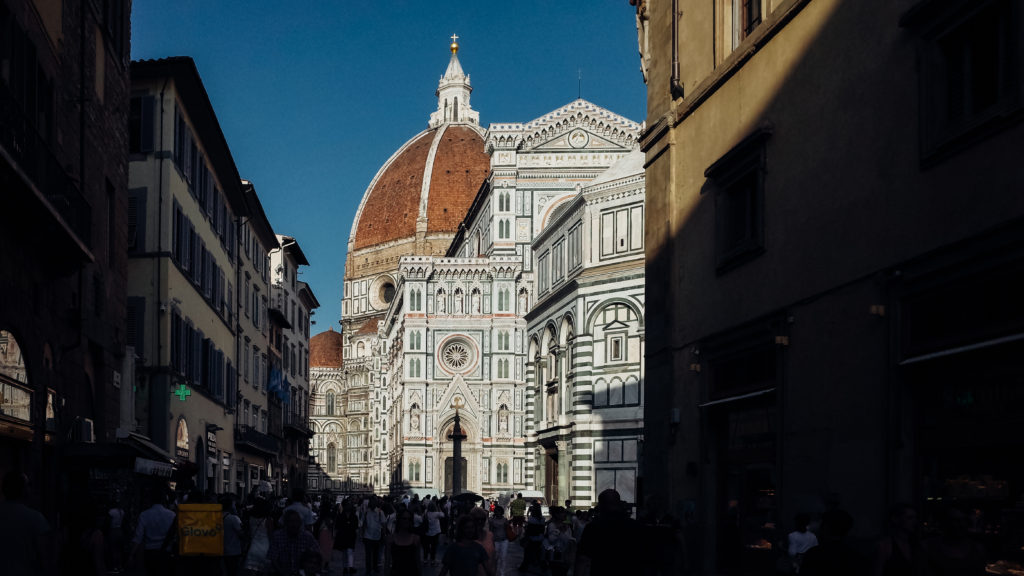
At first, I see the dome from a side street just off the Piazza Santa Maria Novella. Then, as I carry on walking, new walls and details appear. When I stand in front of it, the Florence Cathedral (Cattedrale di Santa Maria del Fiore in Italian) becomes a complete masterpiece.
No wonder it took 140 years to complete: it began in 1296, was designed by Arnolfo di Cambio and was completed in 1436 by the prolific Filippo Brunelleschi. Colorful marble in green and pink, astonishing details, and Giotto’s Campanile. Is there really anything more to ask right here, right now, at Piazza del Duomo of Florence? I bet no.
The Duomo of Florence is visible from multiple spots in the city. It emerges like a spaceship, carrying every legendary name of the Renaissance, even Leonardo da Vinci. I circle the Duomo, trying to capture every detail; it proves impossible. But I don’t get disappointed. As if all that matters today is walking around the Cathedral, I search for the perfect instant. People taking countless selfies somehow spoil the moment, but as I will discover later, Florence doesn’t care about them.
No meat in Ponte Vecchio
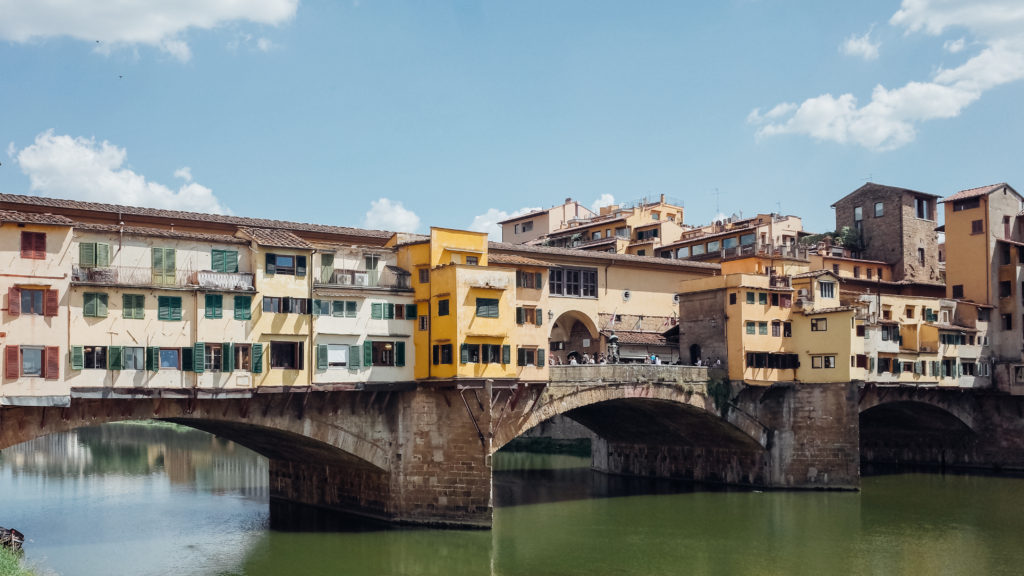
Several months ago, I wrote to you about the Kapellbrücke in Lucerne. I was thrilled and impressed. But today, after walking up and down the Ponte Vecchio in Florence several times, I must admit that this bridge is the epitome of bridge-making. The Ponte Vecchio has existed since 996, and although it was destroyed several times by floods, it still stands in its place. It was also the only monument of Florence that wasn’t destroyed during World War II by the Germans.
The Ponte Vecchio is a unique bridge above the Arno River because it still has shops. Although the first owners of the shops were butchers, the local authorities soon excluded them. Nowadays, most of the shops of the Ponte Vecchio belong to art dealers and goldsmiths. The bridge has three arches, the middle one being the longest. But as a bridge bigger than life, the Ponte Vecchio hosts a detail that seems to expand its importance: a part of the Vasari Corridor is running on top of it.
The Vasari Corridor is, in fact, a passageway on top of the bridge connecting the Palazzo Vecchio with the Palazzo Pitti. It owes its existence to a duke, Cosimo I de’ Medici, who wanted to move between his residence and the government palace without dealing with the rest of the citizens. Insecurity among monarchs was common in the day, but there was another slight problem: the passageway should go through the Ponte Vecchio. And this was a problem because the butchers used the bridge to showcase the meat: the smell was horrible.
The solution was simple and probably typical of a monarch: he prohibited the butchers from running stores on the bridge. The ban is still valid today.
Before sunset in Florence
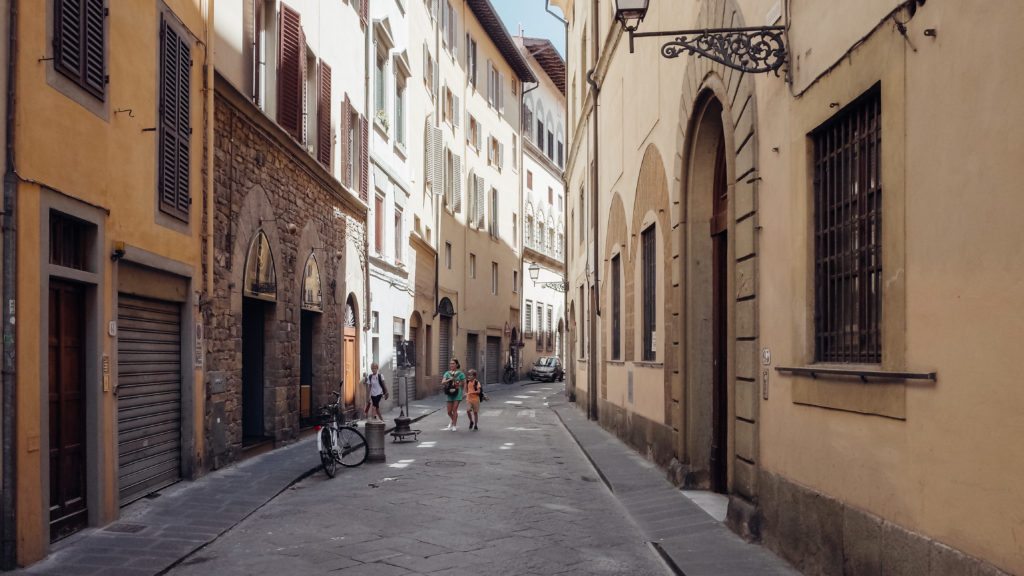
On the last day in Florence, I rush around the city, trying to see everything. This is not a city anymore, but probably the biggest open-air museum in Europe. I know it’s impossible to get a good impression of everything, and I’m thinking of Christopher Isherwood and the opening line of his Goodbye to Berlin novel: “I am a camera with its shutter open, quite passive, recording, not thinking.”
And that’s precisely what I do on the last day in Florence. I walk around the city and try to be a camera -even though I have one in hand. I start at Piazza della Signoria, and after sipping an Americano (I know: I do this all the time), I continue to Uffizi, the world-famous museum. Although I try to queue -I forgot to buy a ticket online- the aura of the city makes me think that every face I see queuing is, in fact, a painting of the Renaissance. So, demotivated as I am, I promise to visit Uffizi the next time I’m in Florence.
The Palazzo Vecchio nearby is a tempting option, but I’d rather walk the Ponte Vecchio again and see if there are any details I missed. Plenty, actually. And then, I walk up to Piazzale Michelangelo (Michelangelo Square). I walk through the shadows, and that unpleasant gutter smell of Florence sticks under my nose.
When I finally reach the Piazzale Michelangelo, the view is fantastic: one can have a complete panorama of the city and see the landmarks next to each other. Then, after taking some photos of David, a copy of the famous sculpture by Michelangelo, I walk again towards the Duomo, visiting Dante’s house in between.
The funeral at Duomo
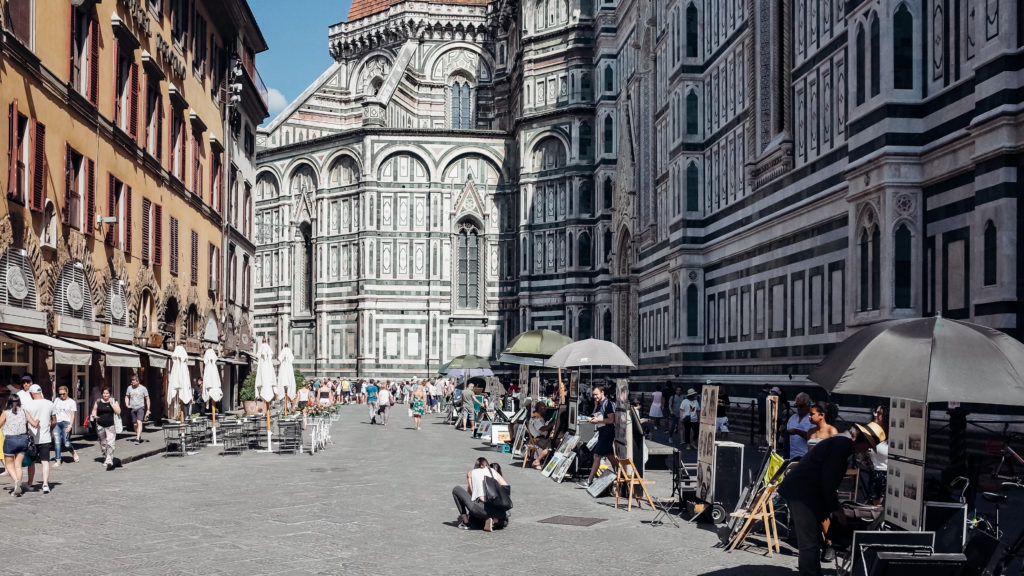
But then, when I reach the Duomo, I see a big crowd. There are more people than on previous days. A policeman tells me that today is the funeral of the famous Italian director Franco Zeffirelli. I know, of course, the name: Jesus of Nazareth has been presented for over 20 consecutive years in Greece every Easter.
Friends, fans, and people that appreciated him are here for the last farewell, and the place is crowded. You can, once again, feel the aura of Florence: it seems to me like a Renaissance painting, perhaps a modern version of Gustave Courbet’s, A Burial at Ornans.
I embark on buses and trams, walk fast, and drink espressos. And then, just shortly before sunset, I end up at Ponte Alle Grazie. The bridge looks straight at Ponte Vecchio. The street lamps are lit, the shadows grow longer, and the people escape daily life by sitting at cafes. It’s never too late for an Aperitivo in Italy, and I sit for one, too. How can one really resist Italian rituals?
Alcohol, paintings, Renaissance, bridges, and legendary inhabitants. I’m sitting there, and I would love to see a new Renaissance in Europe. So, what are you waiting for, Florence? Can’t you lead one?
Florence waiting for the Barbarians
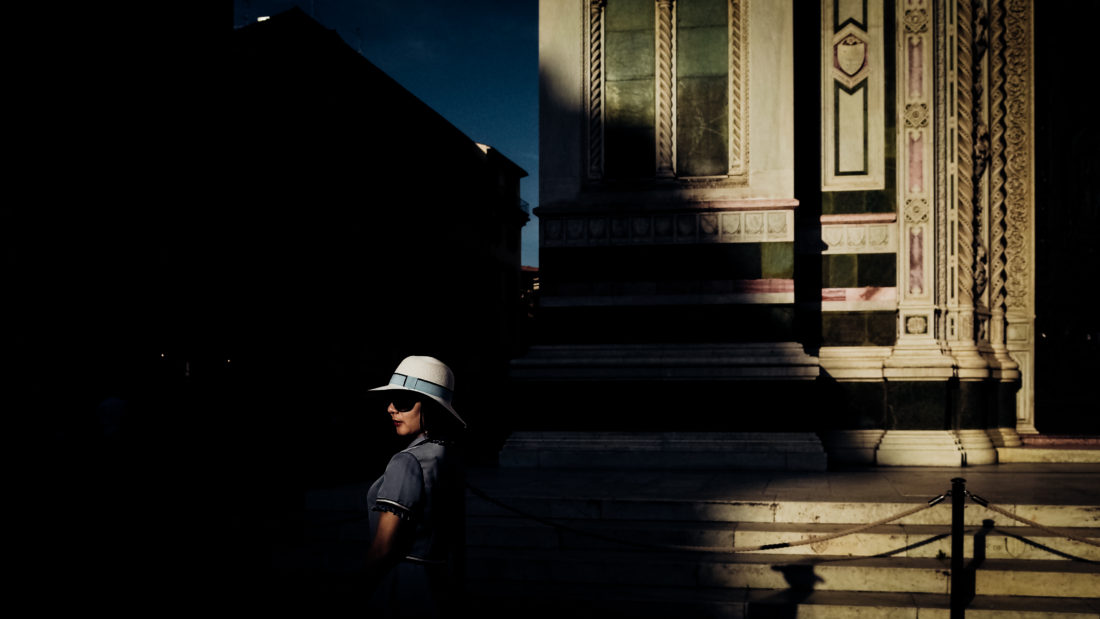
Florence is like one of those long-lost paintings of old masters. The first impression makes you somehow doubtful: seeing the suburbs of Florence made me think that this is not the real thing -exactly like when looking at a painting of dubious origin. But then, after exploring Florence for a few days, I felt in awe. It’s -so to say- like the moment of validating that this is a painting by an old master. You stay there, admire it, and wonder how you could probably be so naive to question its beauty.
Goodhearted and slightly distant, like most the legendary European cities, Florence awaits the studious visitor to discover its charm and not the apparent beauty. However, one should never forget that Florence is a city established by Julius Ceasar in 59 BC as a settlement for his veteran soldiers. The city itself was planned like a military camp. Veterans and a camp don’t sound tempting to me but mix discipline and fertile land with some vision, and you might see it flourish.
I often complain about loads of tourists shooting the most stupid selfies -the apogee of that attitude being Prague. In Florence, I saw that odd ecosystem again with the front-camera-obsession. Vanity and narcissism seem to become the true raison d’être of the 21st century -and once again, I ask myself, “why do we really travel?”
But luckily, Florence didn’t seem to care that much. The place where veterans retire, and at the same time, the capital of the Renaissance: ready for battle and innovation, Florence is waiting for the Barbarians without any intention of surrender.
I’ll write to you from Bologna,
George
More about Florence: The best art tours in Florence, Facts about Florence,
More about Italy: San Gimignano, Pienza, Catania travelogue, Visiting Taormina, Majestic Syracuse
*Get my FREE Travel Writing Course*
Pin it for later
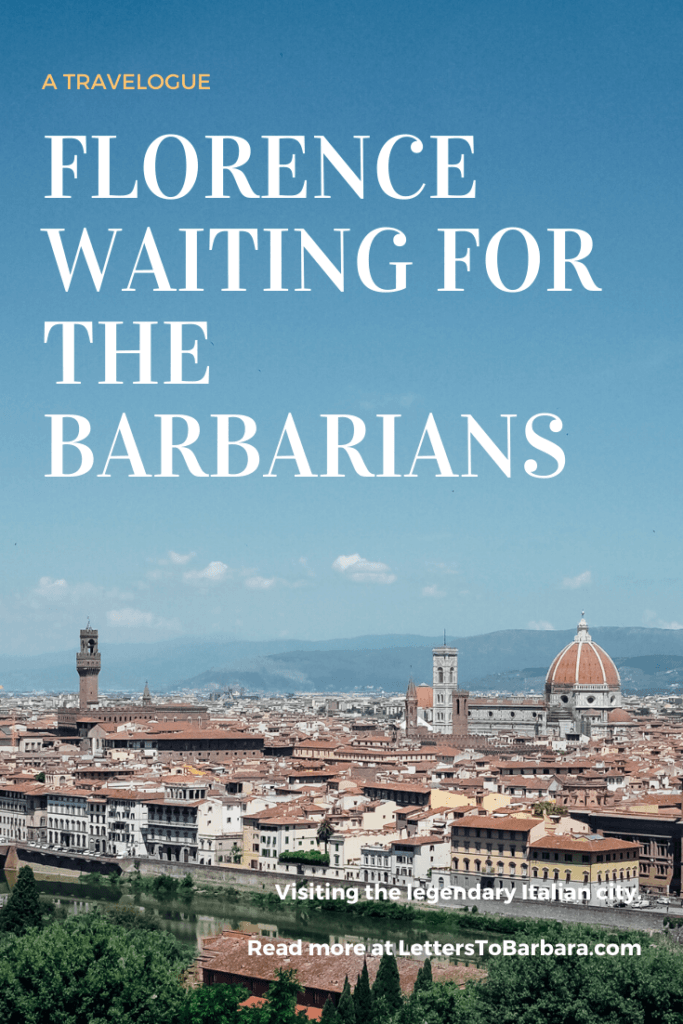
Please share, tweet, and pin if you enjoyed reading Florence waiting for the Barbarians. Your support keeps this website running and all the info up-to-date. 🙂
Last Updated on June 18, 2022 by George Pavlopoulos

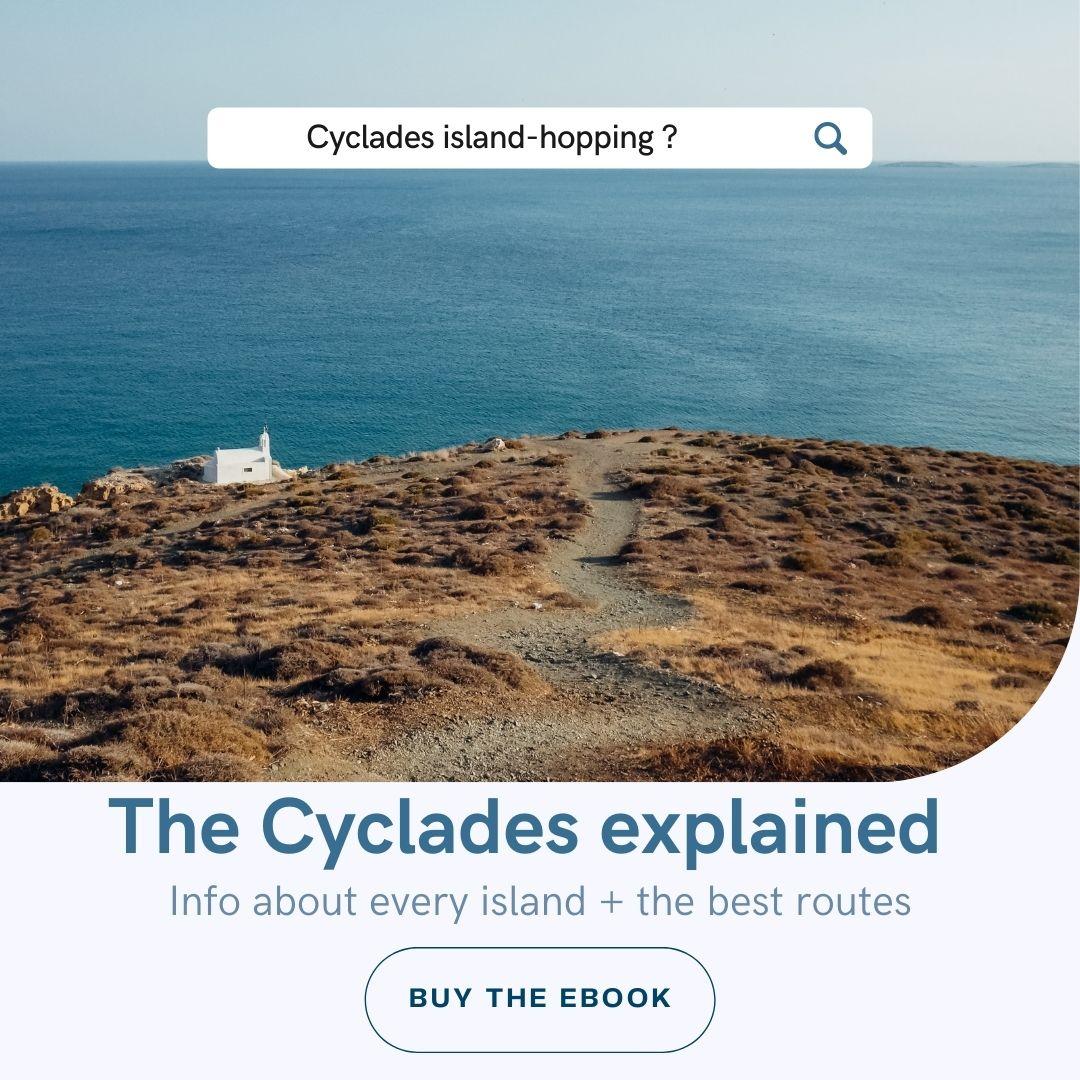
Hi George, Florence is a very interesting city and the story about the Ponte Vecchio bridge being the only monument in Florence to have survived World War II is incredible! I wonder if it was a direct order from Hitler maybe? I also heard about this remarkable story in Florence when I spent a couple of days in the city years ago. Walking across this bridge was very enjoyable. My main overall impression of Florence was their love of art. I really enjoyed seeing some of the statues around the place like Perseus with the head of Medusa, Hercules and Cacus, and the Fountain of Neptune. The Ufizzi Gallery is really good but I rushed through it way too fast due to limited time and so have limited memories as a result. I wish I had more time to slowly take it all in, spend more time admiring the Birth of Venus painting at the Ufizzi, have lots of coffees, etc. I think Florence is one of those cities you could go back to time and time again and never get bored. John
Hey John, I wish I had more days in Florence. I was traveling around Italy, so I just spent a couple of days in the city. Florence is stunning, exactly as you described it. I don’t know if it was Hitler’s direct order or not regarding the Ponte Vecchio, but it doesn’t matter to me that much. Nonetheless, Florence is a masterpiece, and I would love to return soon. Hopefully, after the pandemic. As you read, I didn’t visit the Uffizi this time, so it’s a must for my next journey to Florence. It’s a truly fascinating city.
All the best,
George
George, I would love to stay in Florence and Tuscany for a year even. Another thing, thanks so much for your FREE Travel writing course. I finished it the other day and wow what an amazing succinct course you have put together. Every writer/blogger or wannabe would benefit from your FREE writing course because it is really really good! I’m so glad I signed up for it because I’m normally disappointed when receiving something for free after joining a mailing list. I’m a big fan of popular travel blogger Nomadic Matt and think even someone as successful as him could benefit from taking your writing course. Sadly he has lost the plot a bit in recent years and now I see why. I know what to focus on now so hopefully my own blog content will start to improve. Must go back and fix things in all my previous posts. Thanks again, John
Dear John, that’s so nice to hear/read! I’m glad that you found the FREE Travel Writing Course useful. I thought of writing down the tips that could be helpful for anyone willing to write. It’s actually how I also write. It means a lot 🙂 Take care and stay safe 🙂
George, one last thing from me for this post. I keep spelling Ufizzi like this but it is actually spelt Uffizi Gallery, with two f’s, not two z’s. I have a post of mine I did a while back titled: Uffizi Gallery in Florence: 20 Greek Mythology Masterpieces which will help you plan your next trip to Florence. The writing sucks but it is informative. This post also reveals one of the best kept secrets in Florence that I wish I had experienced. Best regards, John
Indeed, John. I’ll correct the spelling in the comments as well. I just checked your guide about Ufizzi, it’s very very informative. Thanks for sharing it here 🙂 All the best, George